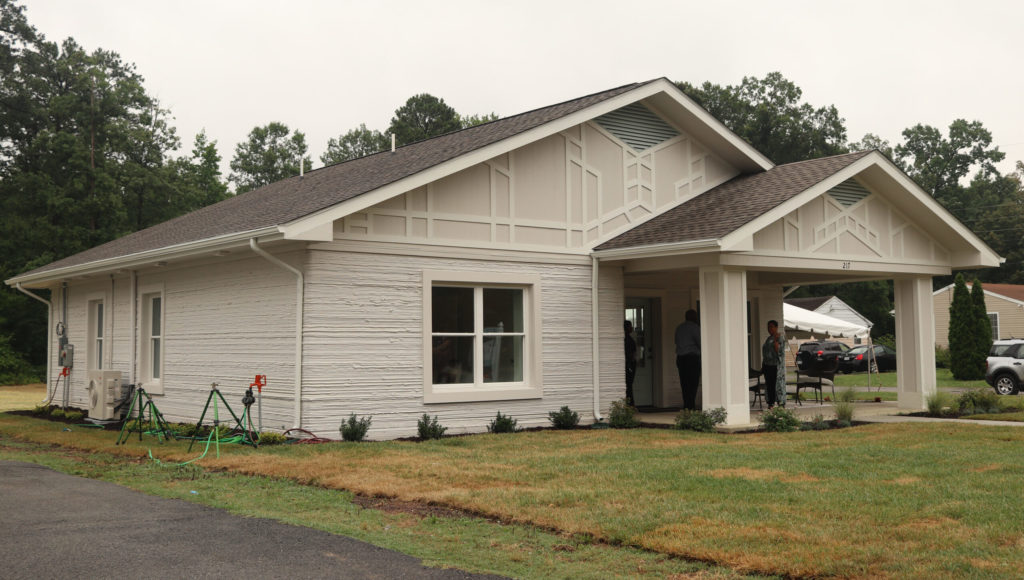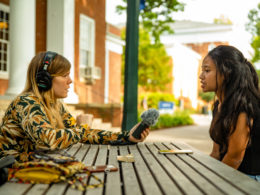The next frontier of housing is officially here. The first 3D-printed home in Richmond was completed and sold in June. Just like any historic achievement, this milestone was preceded by years of hard work and dedication.
The Phil has been following this story since last summer when we published a piece on the groundbreaking technology and the nonprofit, Virginia Housing, that supported it behind the scenes. It all started when Virginia Housing awarded $500,000 to Virginia Center for Housing Research (VCHR) to help fund the construction of the home. Virginia Housing hopes this home and others like it will offer an affordable housing option and bridge the growing gap between housing supply and housing demand.
The construction team made up of Project:HOMES, RMT Construction & Development and Alquist 3D ran into all sorts of problems during the construction process. From the 3D printer arriving five months late to a stolen printer nozzle and concrete-cooling issues, the team had their hands full. However, all of these “setbacks” allowed the construction team to create better and more efficient plans for other ongoing 3D-printed homes. All of their hard work came to fruition as Tiffany Terrell, a first-time homeowner, now lives in this beautiful three-bedroom home in Midlothian with her daughter.
We caught up with Virginia Housing’s Director of Strategic Housing, Chris Thompson, to discuss the future of housing in Virginia, 3D printing and more.

What does the completion of the first 3D-printed house in Virginia mean for Virginia Housing and housing in general?
We are super excited about the completion of the house in Richmond and also the other house that was built in James City County. Now we have two 3D-printed homes and more in the pipeline. For us, this just means another way to increase inventory, which is one of our biggest goals as there is a lack of housing right now, both in terms of renting and homeownership. With this deficit in mind, we’re very excited that we were able to bring this new technology to Virginia, go through a research and development stage, tinker with prototypes and get it implemented.
It’s been great to see the advancements just from the first house to the second house in terms of efficiencies. We’re really just getting the hang of how to use this technology. Going forward, we really think there’s a huge potential for this to continue to grow and expand, not just in Virginia, but across the country.
How replicable is this process? Do you believe this will help close the housing gap in Virginia going forward?
I certainly think it’s going to help close the gap. Again, this isn’t the “silver bullet” that’s going to solve everything. We still need all of our other means of building but, we think 3D-printing offers a lot of potential in terms of building more homes and we’re seeing the pipeline continue to grow. There’s a tremendous amount of interest from localities around the state as well as other development partners.
In terms of research and development, there are a lot of potential improvements. For example, we’re experimenting with other building materials. So, it doesn’t always have to be concrete. Additionally, we’ve begun looking at other alternatives that may be more cost effective, more durable or have better energy efficiency characteristics. We think there’s a large role that our university partners can play in terms of helping to expand this beyond basic concrete into other types of materials as well. It’s not just the homebuilding industry that’s growing from this experience but there’s a whole industry that can also take off around research and material development.
There are a lot of ways this process can expand. Concrete is certainly a proven building material, tried and true. We are still looking at ways that we can either improve that mixture by adding other additives and polymers, or replace it altogether and look into completely different building materials. The 3D-printer was primarily printing the wall system, but there’s also an opportunity to start printing other components inside the home. That’s why you would want to look at things beyond concrete. There’s the potential to start making cabinets and islands in the kitchen and other accessories in the house with the printer. Building a wall system is the first step, now we want to see how we can start doing more with this type of technology.
What is your vision for 3D-printed homes in Virginia going forward?
At this point we’re going to continue to work with private partners like Alquist, who are out there on the cutting edge of building. We’re here to try and help support new as well as existing technologies in order to serve our consumers. We can do that by dispersing funds from our innovation grant. To that end, we will continue to work with companies like Alquist and continue to make introductions with different partners and local governments.
Beyond that we envision that there’s going to be some future partnerships to help support this work. We are in constant communication with Alquist about future opportunities. We’re excited that we’ve got a company like Alquist that is very invested in Virginia and wants to continue to work here. Alquist has made a commitment to build 200 homes in the state and they’re looking at rural areas. Southern and Southwest Virginia are their real targets of opportunity. So, we’re excited about that. They already have two new printing projects starting in Pulaski. I believe after that they have some teed up in the city of Roanoke. They just continue to build interest and demand for this.
What has been the most challenging experience you’ve had while working for Virginia Housing?
I would say capacity. It’s hard business to go out and build housing, whether it’s multi-family rentals or new homeownership. We struggled at times finding partners that have the capacity to execute in all parts of the state. There are areas with a really strong network like Richmond and Northern Virginia, that have a lot of development capacity in addition to access to other resources. But there are other parts of the commonwealth where we don’t necessarily have that kind of developer infrastructure. So, it’s a challenge because we know the need is just as acute in those areas as other places. We just don’t always have a mechanism to get out and get new homes built as quickly as we’d like. As a way of addressing this problem we try to constantly build new partnerships, invest in the right organizations and administer training and assistance to developers on how to increase their development capacity.
What has been the most rewarding experience you’ve had while working for Virginia Housing?
Every time we see a new house being built or new apartment coming online, that’s really exciting. I know that sounds a little mundane, but even for the 3D-printed house that we just completed in Richmond, we had an open house and celebration for the new homebuyer the other week. It’s one thing to walk into the house and say “Wow, this looks great.” But it goes to a different level when the homebuyer is there with their family. We got to meet Tiffany and her daughter and were able to hear her backstory and the challenges she’s experienced. She’d been looking for a house for six months and kept getting outbid and had people that were bringing all cash to the table. So, it really is fulfilling when you get to see the human element and hard work that so many people put into this project translate into reality. It’s just fantastic to see someone walk into their first home that they own. Getting to see the happiness on their face means the world to us. The new technology is great and certainly exciting. When the printer arrives and you unpack it and start testing it out, it can be a unique experience. However, when you see the final outcome, that’s what makes it all worth it.
How can the community get involved or be an advocate for Virginia Housing?
Just take an interest, not just in Virginia housing but housing and community development issues in general. There are always avenues to make your voice heard. Volunteer at some of the organizations that are out there doing this work, it doesn’t necessarily have to be building houses. We work so much with service delivery agencies and especially those that are out there helping address issues around homelessness. So, there are plenty of great opportunities to volunteer. For us, we work in any community around the state, but there needs to be that kind of groundswell to make something actually happen. We’re just a small part of a larger effort. I think a lot of it’s just becoming engaged in the community. That opens the door for agencies like Virginia Housing to come in and work with partners to get some really good things done.
To learn more about Virginia Housing, visit its website or follow the organization on Facebook, Twitter or Instagram.











While omitted in this article, another Richmond-based housing nonprofit, Better Housing Coalition is also a partner in this 3D home.